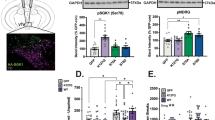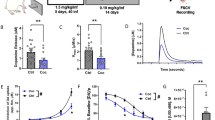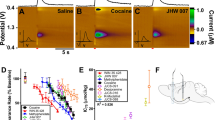Abstract
Repeated exposure to cocaine results in motor sensitization that, in the ventral tegmental area (VTA), is associated to enhanced glutamate release, which in turn leads to enhanced calcium levels in dopaminergic neurons. Calcium influx activates calcium–calmodulin-dependent protein kinases such as CaMKII. D-Serine could participate on these effects, and the objective was to discern the role of VTA D-serine after a sensitizing regimen of cocaine (10 mg/kg daily), and to discern consequent expression changes in CaMKII and its activated form. For this purpose, D-serine, sodium benzoate (inhibitor of D-amino acid oxidase, the degradating enzyme of D-serine), and 7-chlorokynurenate (inhibitor of the glycine site of NMDA receptors) were injected into the VTA (in either the induction or expression phase of sensitization), and activation state of CaMKII was assessed through blotting. The findings indicated that intra-VTA administration of D-serine (5 mM) and sodium benzoate (100 and 200 μg/μl) during the induction phase (not expression) reliably augmented the expression of behavioral sensitization to cocaine, providing evidence that D-serine in the VTA participates in the initiation of motor sensitization to this psychostimulant drug. Intra-VTA infusions of D-serine, sodium benzoate and 7-chlorokynurenate did not elicit a motor effect of their own. Confirming the important role of NMDA receptors and their activation at the glycine site, the employment of 7-chlorokynurenate (2 and 5 μg/μl) led to blocking of the development of sensitization to cocaine. CaMKII within the VTA was found to participate in D-serine's effects because this kinase, that is activated after repeated cocaine, was further activated after co-treatment with D-serine or sodium benzoate. Besides CaMKII activity was otherwise reduced by 7-chlorokynurenate.
Similar content being viewed by others
Log in or create a free account to read this content
Gain free access to this article, as well as selected content from this journal and more on nature.com
or
References
Almond SL, Fradley RL, Armstrong EJ, Heavens RB, Ruttr AR, Newman RJ et al (2006). Behavioral and biochemical chracterization of a mutant mouse strain lacking D-amino acid oxidase activity and its implications for schizophrenia. Mol Cell Neurosci 32: 324–344.
Bartlett E, Hallin A, Chapman B, Angrist B (1997). Selective sensitization to the psychosis-inducing effects of cocaine: a possible marker for addiction relapse vulnerability? Neuropsychopharmacology 16: 77–82.
Beitner-Johnson D, Nestler EJ (1991). Morphine and cocaine exert common chronic actions on tyrosine hydroxylase in dopamine brain reward regions. J Neurochem 57: 344–347.
Berhow MT, Hiroi N, Nestler EJ (1996). Regulation of ERK (extracellular signal regulated kinase), part of the neurotrophin signal transduction cascade, in the rat mesolimbic dopamine system by chronic exposure to morphine or cocaine. J Neurosci 16: 4707–4715.
Berhow MT, Russell DS, Terwilliger RZ, Beitner-Johnson D, Self DW, Lindsay RM et al (1995). Influence of neurotrophic factors on morphine- and cocaine-induced biochemical changes in the mesolimbic dopamine system. Neuroscience 68: 969–979.
Boehning D, Snyder SH (2003). Novel neural modulators. Annu Rev Neurosci 26: 105–131.
Brady KT, Lydiard B, Malcolm R, Ballinger JC (1991). Cocaine-induced psychosis. J Clin Psychiatry 52: 509–512.
Chumakov I, Blumenfeld M, Guerassimenko O, Cavarec L, Palicio M, Abderrahim H et al (2002). Genetic and physiological data implicating the new human gene G72 and the gene for D-amino acid oxidase in schizophrenia. Proc Natl Acad Sci USA 99: 13675–13680.
Curtis J, Finkbeiner S (1999). Sending signals from the synapse to the nucleus: possible roles for CaMK, Ras/ERK, and SAPK pathways in the regulation of synaptic palsticity and neuronal growth. J Neurosci Res 58: 88–95.
Dubnau J, Tully T (1998). Gene discovery in Drosophila: new insights for learning and memory. Annu Rev Neurosci 21: 407–444.
Finkbeiner S, Tavazoie SF, Maloratsky A, Jacobs KM, Harris KM, Greenberg ME (1997). CREB: a major mediator of neuronal neurotrophin responses. Neuron 19: 1031–1047.
Fuchs SA, Berger R, Klomp LW, de Koning TJ (2005). D-amino acids in the central nervous system in health and disease. Mol Genet Metab 85: 168–180.
Goldberg TE, Straub RE, Callicott JH, Hariri A, Mattay VS, Bigelow L et al (2006). The G72/G30 gene complex and cognitive abnormalities in schizophrenia. Neuropsychopharmacology 31: 2022–2032.
Haydon PG (2001). GLIA: listening and talking to the synapse. Nat Rev Neurosci 2: 185–193.
Ho N, Liauw JA, Blaeser F, Wei F, Hanissian S, Muglia LM et al (2000). Impaired synaptic plasticity and cAMP response element-binding protein activation in Ca2+/calmodulin-dependent protein kinase type IV/Gr-deficient mice. J Neurosci 20: 6459–6472.
Huettner JE (1991). Competitive antagonism of glycine at the N-methyl-D-aspartate (NMDA) receptor. Biochem Pharmacol 41: 9–16.
Kalivas PW, Alesdatter JE (1993). Involvement of NMDA receptor stimulation in the VTA and amygdala in behavioral sensitization to cocaine. J Pharmacol Exp Ther 267: 486–495.
Kalivas PW, Duffy P (1998). Repeated cocaine administration alters extracellular glutamate in the ventral tegmental area. J Neurochem 70: 1497–1502.
Karler R, Turkanis SA, Partlow LM, Calder LD (1991). Calcium channel blockers in behavioral sensitization. Life Sci 49: 165–170.
Kartvelishvily E, Shleper M, Balan L, Dumin E, Wolosker H (2006). Neuron-derived D-serine release provides a novel means to activate N-methyl-D-aspartate receptors. J Biol Chem 281: 14151–14162.
Kelley AE (2004). Memory and addiction: shared neural circuitry and molecular mechanisms. Neuron 44: 161–179.
Konno R, Yasumura Y (1992). D-amino-acid oxidase and its physiological function. Int J Biochem 24: 519–524.
Koob GF, Bloom FE (1988). Cellular and molecular mechanisms of drug dependence. Science 242: 715–723.
Licata SC, Freeman AY, Pierce-Bancroft AF, Pierce RC (2000). Repeated stimulation of L-type calcium channels in the rat ventral tegmental area mimics the initiation of behavioral sensitization to cocaine. Psychopharmacology 152: 110–118.
Licata SC, Pierce RC (2003). The roles of calcium/calmodulin-dependent and Ras/mitogen-activated protein kinases in the development of psychostimulant-induced behavioral sensitization. J Neurochem 85: 14–22.
Licata SC, Schmidt HD, Pierce RC (2004). Suppressing calcium/calmodulin-dependent protein kinase II activity in the ventral tegmental area enhances the acute behavioural response to cocaine but attenuates the initiation of cocaine-induced behavioural sensitization in rats. Eur J Neurosci 19: 405–414.
Lim J, Yang C, Hong SJ, Kim KS (2000). Regulation of tyrosine hydroxylase gene transcription by the cAMP-signaling pathway: involvement of multiple transcription factors. Mol Cell Biochem 212: 51–60.
Matthews RP, Guthrie CR, Wailes LM, Zhao X, Means AR, Mcknight GS (1994). Calcium/calmodulin-dependent protein kinases types II and IV differentially regulate CREB-dependent gene expression. Mol Cell Biol 14: 6017–6116.
Miserendino MJD, Guitart X, Terwilliger RZ, Chi S, Nestler EJ (1993). Individual differences in locomotor activity are associated with levels of tyrosine hydroxylase and neurofilament proteins in the ventral tegmental area of Sprague–Dawley rats. Mol Cell Neurosci 4: 440–448.
Morrow BA, Taylor JR, Roth HR (1995). R-(+)-HA-966, an antagonist for the glycine/NMDA receptor, prevents locomotor sensitization to repeated cocaine exposures. Brain Res 673: 165–169.
Nakamura Y, Kitani T, Okuno S, Otake K, Sato F, Fujisawa H (2000). Immunohistochemical study of the distribution of Ca(2+)/calmodulin-dependent protein kinase phosphatase in the rat central nervous system. Brain Res Mol Brain Res 77: 76–94.
Nestler EJ (2001). Molecular basis of long-term plasticity underlying addiction. Nat Rev Neurosci 2: 119–128.
Park K, Shishido Y, Ichise-Shishido S, Kawazoe T, Ono K, Iwana S et al (2006). Potential role for astroglial D-amino acid oxidase in extracellular D-serine metabolism and cytotoxicity. J Biochem (Tokyo) 139: 295–304.
Parsons LH, Justice JB (1993). Serotonin and dopamine sensitization in the nucleus accumbens, ventral tegmental area and dorsal raphe nucleus following repeated cocaine administration. J Neurochem 61: 1611–1619.
Paxinos G, Watson C (2005). The Rat Brain in Stereotaxic Coordinates. Elsevier Academic Press: Amsterdam.
Pierce RC, Born B, Adams M, Kalivas PW (1996). Repeated intra-ventral tegmental area administration of SKF-38393 induces behavioral and neurochemical sensitization to a subsequent cocaine challenge. J Pharmacol Exp Ther 278: 384–392.
Reimer AR, Martin-Iverson MT (1994). Nimodipine and haloperidol attenuate behavioral sensitization to cocaine but only nimodipine blocks the establishment of conditioned locomotion induced by cocaine. Psychopharmacology 113: 404–410.
Robinson TE, Berridge KC (1993). The neural basis of drug craving: an incentive-sensitization theory of addiction. Brain Res Rev 18: 247–291.
Satel SL, Southwick SM, Gawin FH (1991). Clinical features of cocaine-induced paranoia. Am J Psychiatry 1248: 495–498.
Schell MJ, Brady Jr RO, Molliver ME, Snyder SH (1997). D-serine as a neuromodulator: regional and developmental localizations in rat brain glia resemble NMDA receptors. J Neurosci 17: 1604–1615.
Schell MJ, Molliver ME, Snyder SH (1995). D-serine, an endogenous synaptic modulator: localization to astrocytes and glutamate-stimulated release. Proc Natl Acad Sci USA 92: 3948–3952.
Silva AJ, Paylor R, Wehner JM, Tonegawa S (1992). Impaired spatial learning in alpha-calcium-calmodulin kinase II mutant mice. Science 257: 206–211.
Sola C, Tusell JM, Serratosa J (1999). Comparative study of the distribution of calmodulin kinase II and calcineurin in the mouse brain. J Neurosci Res 57: 651–662.
Sorg BA, Chen SY, Kalivas PW (1993). Time course of tyrosine hydroxylase expression after behavioral sensitization to cocaine. J Pharmacol Exp Ther 266: 424–430.
Tao X, Finkbeiner S, Arnold DB, Shaywitz AJ, Greenberg ME (1998). Ca2+ influx regulates BDNF transcription by a CREB family transcription factor-dependent mechanism. Neuron 20: 709–726.
Ungless MA, Whistler JL, Malenka RC, Bonci A (2001). Single cocaine exposure in vivo induces long-term potentiation in dopamine neurons. Nature 411: 583–587.
Vrana SL, Vrana KE, Koves TR, Smith JE, Dworkin SI (1993). Chronic cocaine administration increases CNS tyrosine hydroxylase enzyme activity and mRNA levels and tryptophan hydroxylase enzyme activity levels. J Neurochem 61: 2262–2268.
Williams JM, Steketee JD (2005). Time-dependent effects of repeated cocaine administration on dopamine transmission in the medial prefrontal cortex. Neuropharmacology 48: 51–61.
Wise RA (2000). Addiction becomes a brain disease. Neuron 26: 27–33.
Wise RA, Rompre PP (1989). Brain dopamine and reward. Annu Rev Psychol 40: 191–225.
Yang Y, Ge W, Chen Y, Zhang Z, Shen W, Wu C et al (2003). Contribution of astrocytes to hippocampal long-term potentiation through release of D-serine. Proc Natl Acad Sci USA 100: 15194–15199.
Acknowledgements
Supported by grants to EFE from Spanish FIS (PI040155), Plan Andaluz de Investigacion (CVI127), RED de trastornos adictivos (Instituto Carlos III, RD06/0001), and Delegacion del Gobierno para el Plan Nacional sobre Drogas (3SI/05/14).
Author information
Authors and Affiliations
Corresponding author
Additional information
DISCLOSURE/CONFLICT OF INTEREST
The author(s) declare that, except for income received from their primary employer, no financial support or compensation has been received from any individual or corporate entity over the past 3 years for research or professional service and there are no personal financial holdings that could be perceived as constituting a potential conflict of interest.
Rights and permissions
About this article
Cite this article
Fernandez-Espejo, E., Ramiro-Fuentes, S., Portavella, M. et al. Role for D-Serine within the Ventral Tegmental Area in the Development of Cocaine's Sensitization. Neuropsychopharmacol 33, 995–1003 (2008). https://doi.org/10.1038/sj.npp.1301495
Received:
Revised:
Accepted:
Published:
Issue date:
DOI: https://doi.org/10.1038/sj.npp.1301495
Keywords
This article is cited by
-
NMDA receptor glycine modulatory site in the ventral tegmental area regulates the acquisition, retrieval, and reconsolidation of cocaine reward memory
Psychopharmacology (2012)
-
Sensitization to cocaine is inhibited after intra-accumbal GR103691 or rimonabant, but it is enhanced after co-infusion indicating functional interaction between accumbens D3 and CB1 receptors
Psychopharmacology (2011)
-
The neurobiology of D-amino acid oxidase and its involvement in schizophrenia
Molecular Psychiatry (2010)



